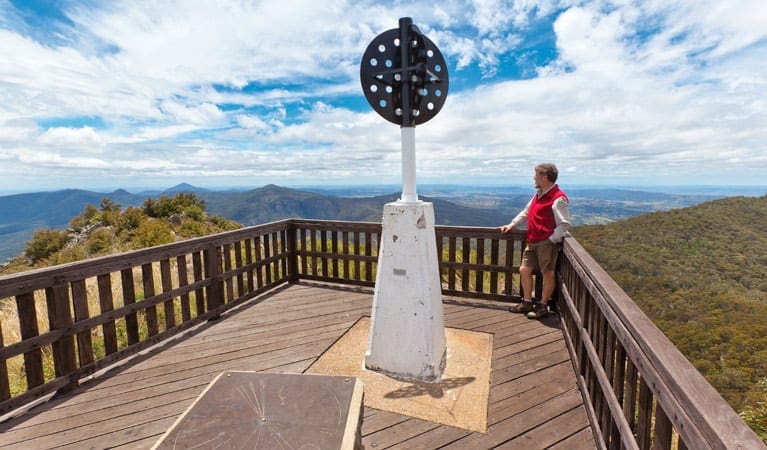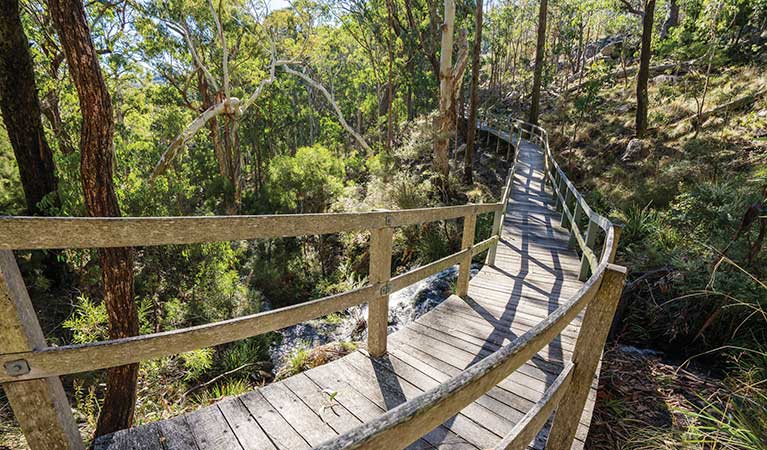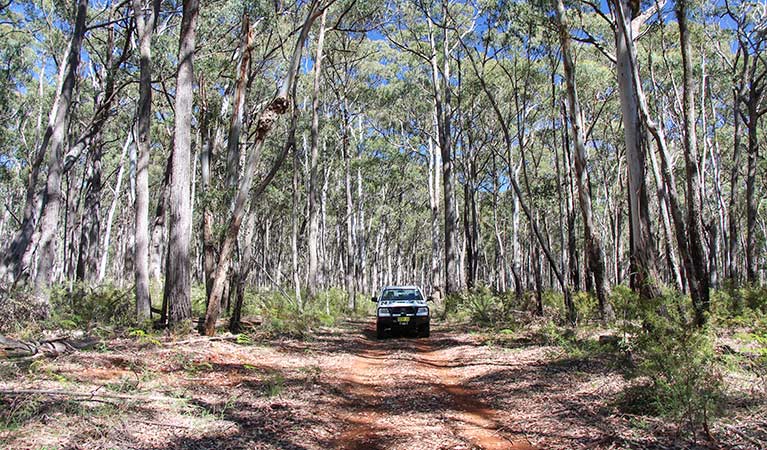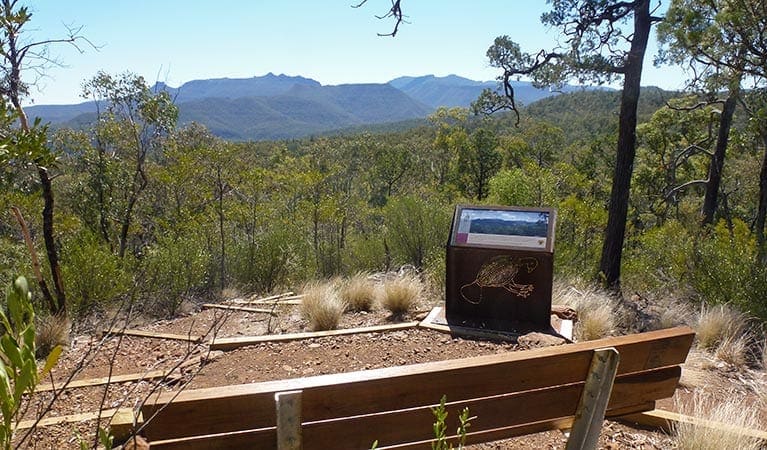Hike at a Glance
Max elevation: 0m
Min elevation: 0m
Total Ascent: 0m
Hike overview
Kaputar Plateau walk is a magnificent and varied 8km walking track set deep in the heart of Mount Kaputar National Park. It's a great walk for budding bushwalkers and avid birdwatchers keen to enjoy the wide open spaces and dramatic mountain ranges of North West NSW, near Narrabri.
Enjoy a taste of early Australian pioneer history whilst walking along the original 'pioneer's track' from Coryah Gap to Dawsons Spring.
Venture through a range of landscapes and vegetation before arriving at Euglah Rock with spectacular scenic views of Camels Hump and Mount Coryah. Experienced rock climbers can test themselves on nearby cliffs while mountain bikers can ride this moderately difficult trail.
Tips
The road from the park entrance is steep and a single lane. Caravans are not permitted.
Remember to take your binoculars if you want to go birdwatching
The weather in this area can be extreme and unpredictable, so please ensure you're well-prepared for your visit.
There is limited mobile reception in this park
Visit NSW National Parks and Wildlife Service for more information on this trail.
The longitude and latitude of the start and end points are approximately only and should not be used for navigation purposes. Please contact me if you know the correct coordinates.
Gallery
Got some great shots from this hike? Upload your photos here to inspire others and show off the beauty of the trail!
Click to view form >>
Submitting your photos doesn’t mean you lose ownership. You can be credited for your contributions, and you can request removal at any time.
Content use
Please don’t copy GPX files or content from this site to AllTrails or other platforms. Each trail has been personally mapped, documented, and refined to support Australia’s bushwalking and hiking community. While some details come from land managers, every listing reflects significant personal effort. This is a free, community-driven initiative—your respect helps keep it that way.
Walk map and GPX file
It looks like I don’t have a GPX file for this trail yet. If you have one to share, please email it to me! I’ll verify it against official maps before adding it to help other hikers have a safer, easier experience. Thanks for contributing to a better hiking resource.
Getting there
Getting to the trailhead: Mount Kaputar National Park.
Kaputar Plateau walk is in Kaputar precinct within Mount Kaputar National Park. To get there:From Narrabri take Old Gunnedah Road southAfter about 2.5km turn left onto Kaputar RoadFollow Kaputar Road for 27km to Mount Kaputar National Park entranceBark Hut turn-off is 14km on the rightRocky Plateau trail trackhead is 2km beyond Bark Hut on the rightWith 2 cars you can leave one at Bark Hut and the other at the start of Rocky Plateau Fire Trail, you can then enjoy the 6km down hill walk between the trailhead to Bark Hut. Otherwise it’s 2km up the main road back to your starting point. Parking Parking is available at the Rocky Plateau trail trackhead.
Closest towns to this walk: Baan Baa, Baradine, Bellata, Bingara, Bundarra, Coonabarabran, Gunnedah, Manilla, Moree, Narrabri, Walgett, Wee Waa
About the region
With camping, cycling, walking, horse riding and bird watching waiting for you on this scenic mountain range, Mount Kaputar is a fantastic wilderness escape in NSW. Be awed by towering forests, breathtaking rock formations and stunning scenery at Mount Kaputar National Park. Roughly 1 hour's drive from Narrabri in northern NSW, Mount Kaputar is an explorer's paradise.
Take in the views from the park's lookouts, have a relaxing picnic or barbecue, or stay overnight in a picturesque campground or cabin accommodation. Bring your binoculars to enjoy bird watching, or to search for possums and greater gliders after dark. Or for a more adventurous trip; walk one of the park's many tracks, or go for a mountain bike or horse ride through the spectacular landscape.
Similar walks nearby
Looking for more walks in or near Mount Kaputar National Park? Try these trails with a similar difficulty grade.
Track grade
Grade 3 (Moderate) - Walks for Most Fitness Levels: Grade 3 on the AWTGS represents moderate walking tracks. These are ideal for walkers with some fitness who are comfortable with some hills and uneven terrain. While suitable for most ages, some bushwalking experience is recommended to ensure a safe and enjoyable experience. Tracks may have short, steep hill sections, a rough surface, and many steps. The total distance of a Grade 3 walk can be up to 20 kilometers.
Explore safe
Plan ahead and hike safely! Carry enough water, pack layers for changing conditions, and bring safety gear like a torch, PLB, and reliable communication device. Check official sources for trail updates, closures, and access requirements, and review local weather and bushfire advice. Most importantly, share your plans with someone before you go. Being prepared makes for a safer and more enjoyable hike! Stay Safe, Explore More, and Always #ExploreSafe.
Packing checklists
What you carry in your pack depends on factors like weather, terrain, and your adventure type. Not sure what to bring? My free planning, food, and packing checklists are a great starting point, covering day hikes, overnight trips, and multi-day adventures. Use them to customise your kit and always prioritise safety.
Let someone know
Before heading out, take a moment to fill out your trip intentions form. It’s a quick way to share your hike details with family or friends. If something goes wrong, they can notify emergency services, ensuring a faster response and peace of mind. Stay safe and enjoy your adventure
Suggest an edit
Spotted a change on this trail? Maybe there are new features, the route has shifted, or the trail is permanently closed. Whatever the update, I’d love your input. Your feedback helps fellow hikers stay informed and ensures that our trail info stays fresh and reliable.
Acknowledgement of Country
Trail Hiking Australia acknowledges the Traditional Owners of the lands on which we hike and pay respects to their Elders, past and present, and we acknowledge the First Nations people of other communities who may be here today.






